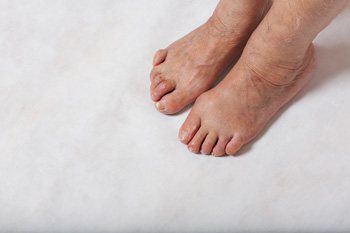How Footwear Affects Hammertoe
Tuesday, 12 July 2022 00:00
To maintain healthy, strong feet, it is imperative to be familiar with common foot conditions, their causes, and how to prevent them. One troubling foot affliction that could threaten the vitality of your feet is called hammertoe, which has a notable causal relationship with certain kinds of footwear. Hammertoe affects the second, third, or fourth toe, occurring when an imbalance in the muscles around the toe’s middle joint causes the toe to stick up at the affected joint. This causes the toe to resemble a hammer. The condition, if left untreated, can make it especially difficult or painful to walk. Importantly, your choice of footwear can impact your likelihood of developing hammertoe. For example, shoes with small toe boxes that leave little room for the toes to sit comfortably in the shoe can force the toes into tight, twisted contortions. These contortions tighten the muscles in your toes, making hammertoe more likely. Additionally, high-heeled shoes can force your toes into tight, uncomfortable positions that might also tighten your muscles in the toes. To decrease your chances of developing a hammertoe, you might choose lower-heeled shoes with spacious toe boxes. If you think you have hammertoe or want to learn more about ways to prevent this condition, reach out to a podiatrist.
Hammertoe
Hammertoes can be a painful condition to live with. For more information, contact Dr. Eugenio Rivera from Calo Foot & Ankle Specialists. Our doctor will answer any of your foot- and ankle-related questions.
Hammertoe is a foot deformity that affects the joints of the second, third, fourth, or fifth toes of your feet. It is a painful foot condition in which these toes curl and arch up, which can often lead to pain when wearing footwear.
Symptoms
- Pain in the affected toes
- Development of corns or calluses due to friction
- Inflammation
- Redness
- Contracture of the toes
Causes
Genetics – People who are genetically predisposed to hammertoe are often more susceptible
Arthritis – Because arthritis affects the joints in your toes, further deformities stemming from arthritis can occur
Trauma – Direct trauma to the toes could potentially lead to hammertoe
Ill-fitting shoes – Undue pressure on the front of the toes from ill-fitting shoes can potentially lead to the development of hammertoe
Treatment
Orthotics – Custom made inserts can be used to help relieve pressure placed on the toes and therefore relieve some of the pain associated with it
Medications – Oral medications such as anti-inflammatories or NSAIDs could be used to treat the pain and inflammation hammertoes causes. Injections of corticosteroids are also sometimes used
Surgery – In more severe cases where the hammertoes have become more rigid, foot surgery is a potential option
If you have any questions please contact our office located in Bellaire, TX . We offer the newest diagnostic and treatment technologies for all your foot and ankle needs.









